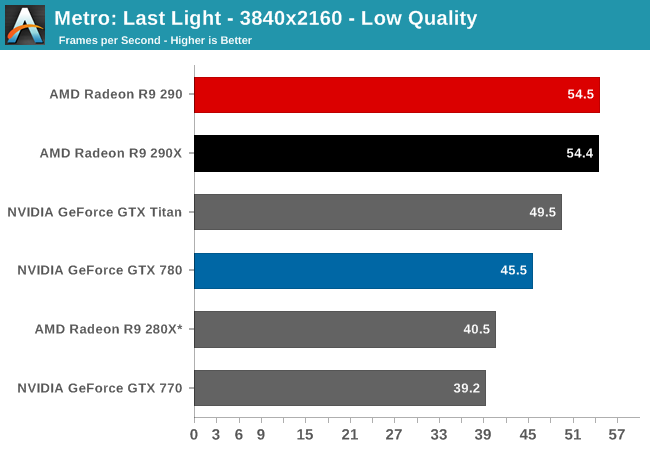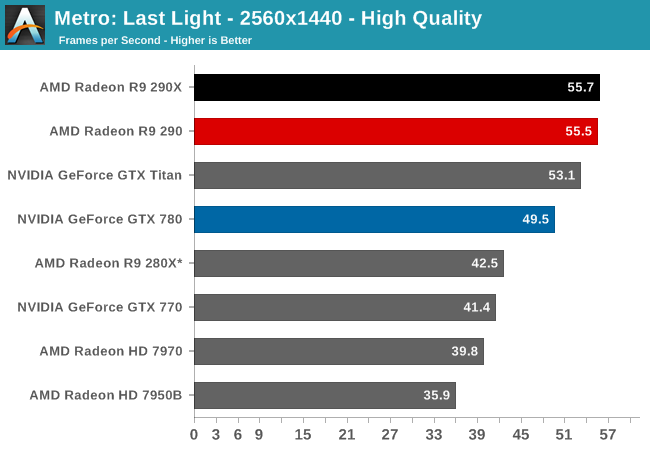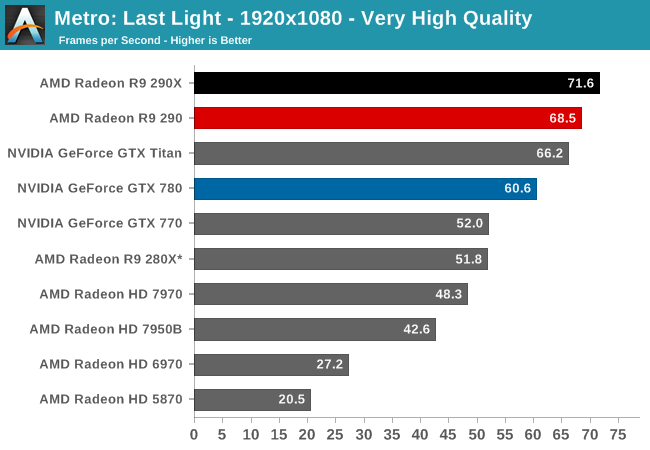The AMD Radeon R9 290 Review
by Ryan Smith on November 5, 2013 12:01 AM EST- Posted in
- GPUs
- AMD
- Radeon
- Hawaii
- Radeon 200
Metro: Last Light
As always, kicking off our look at performance is 4A Games’ latest entry in their Metro series of subterranean shooters, Metro: Last Light. The original Metro: 2033 was a graphically punishing game for its time and Metro: Last Light is in its own right too. On the other hand it scales well with resolution and quality settings, so it’s still playable on lower end hardware.



For the bulk of our analysis we’re going to be focusing on our 2560x1440 results, as monitors at this resolution will be what we expect the 290 to be primarily used with. A single 290 may have the horsepower to drive 4K in at least some situations, but given the current costs of 4K monitors that’s going to be a much different usage scenario. The significant quality tradeoff for making 4K playable on a single card means that it makes far more sense to double up on GPUs, given the fact that even a pair of 290Xs would still be a fraction of the cost of a 4K, 60Hz monitor.
With that said, there are a couple of things that should be immediately obvious when looking at the performance of the 290.
- It’s incredibly fast for the price.
- Its performance is at times extremely close to the 290X
To get right to the point, because of AMD’s fan speed modification the 290 doesn’t throttle in any of our games, not even Metro or Crysis 3. The 290X in comparison sees significant throttling in both of those games, and as a result once fully warmed up the 290X is operating at clockspeeds well below its 1000MHz boost clock, or even the 290’s 947MHz boost clock. As a result rather than having a 5% clockspeed deficit as the official specs for these cards would indicate, the 290 for all intents and purposes clocks higher than the 290X. Which means that its clockspeed advantage is now offsetting the loss of shader/texturing performance due to the CU reduction, while providing a clockspeed greater than the 290X for the equally configured front-end and back-end. In practice this means that 290 has over 100% of 290X’s ROP/geometry performance, 100% of the memory bandwidth, and at least 91% of the shading performance.
So in games where we’re not significantly shader bound, and Metro at 2560 appears to be one such case, the 290 can trade blows with the 290X despite its inherent disadvantage. Now as we’ll see this is not going to be the case in every game, as not every game GPU bound in the same manner and not every game throttles on the 290X by the same degree, but it sets up a very interesting performance scenario. By pushing the 290 this hard, and by throwing any noise considerations out the window, AMD has created a card that can not only threaten the GTX 780, but can threaten the 290X too. As we’ll see by the end of our benchmarks, the 290 is only going to trail the 290X by an average of 3% at 2560x1440.
Anyhow, looking at Metro it’s a very strong start for the 290. At 55.5fps it’s essentially tied with the 290X and 12% ahead of the GTX 780. Or to make a comparison against the cards it’s actually priced closer to, the 290 is 34% faster than the GTX 770 and 31% faster than the 280X. AMD’s performance advantage will come crashing down once we revisit the power and noise aspects of the card, but looking at raw performance it’s going to look very good for the 290.










295 Comments
View All Comments
TempAccount007 - Saturday, November 9, 2013 - link
What part of REFERENCE COOLER do you not understand?johnny_boy - Wednesday, November 13, 2013 - link
The IF isn't so big, I think. A lot of gamers already have blocks for their graphics cards, or don't care much about the additional noise, or want a block anyway at some point and the 290 presents an opportunity to get one now (and then cooling is quieter/better than the competing nVidia cards for the same price when figuring in the watercooling costs for the AMD card). I'd rather get the 290 (over the 780) and use my current watercooling solution. If I didn't have watercooling then I'd still rather buy the 290 and upgrade to watercooling.Eniout - Thursday, November 14, 2013 - link
my Aunty Julia recently got Jeep Compass SUV by working from acomputer. read the full info here www.Jobs37.coℳ
tgirgis - Thursday, February 20, 2014 - link
That's really extremely one sided, first of all, AMD already has a response to G-Sync, (their version for now has been dubbed "Free-Sync" but no idea if that nomenclature is final) and they have TressFX (which, at the moment, does look better than Nvidia's "Hairworks" but Nvidia will probably soon catch up), and they've got Mantle, which is definitely a massive advantage.Not to mention the R9 290 comes with 4GB Vram, as opposed to the GTX 780's 3GB, though it's really not a huge issue except in 4k gaming. Finally, shield compatibility isn't really a benefit, it's a $250 handheld game system, it's only beneficial if you interested in purchasing one of those, as opposed to being an included feature.
Nvidia is not without it's advantages however, they still have lower power consumption and thermals which is great for mini-itx systems (although manufacturer custom cooled cards can help bridge the gap for thermals) and they do still have Physx.
If Mantle keeps going the way it is now, Nvidia might be forced to pay royalties to AMD similar to how they did with Intel a few years back. If anything, AMD should throw "Allow us to use Physx" in the negotiations :)
slickr - Tuesday, November 5, 2013 - link
O yeah, Nvidia at this point has no choice, but to lower its prices again. I mean for $400 this card is amazing. It performs on the same level as the $1000 Titan and on the same level as the $550 290X, so a giant performance at a very cheap price.Even with the high noise(just wait 2 weeks for custom cooler) this card blows the GTX 780 out of the water, the performance is so much better.
I think if Nvidia wants to stay in the competition they would need to cut the GTX 780 price to at least $400 as well and try and get sales due to better acoustics and a lower power consumption, but if it was just performance in question they would need to lower the price of the 780 to $350 or 300 euros.
Of course that would mean that the 770 should get a price reduction as well and be around $270.
holdingitdown - Tuesday, November 5, 2013 - link
Yes this card is incredibly disruptive. The performance makes the 780 look like a mess. Expect to see at least another $100 slashed off the 780 and the 770 needs a little more taken off.The R9 290 is a monster!
crispyitchy - Tuesday, November 5, 2013 - link
Best card to release yet as far as I am concerned.The noise profile is not perfect, but every card is noisy once gaming to one degree or another.
What is perfect is the giant performance for this perfect price.
Newegg here I COME
Wreckage - Tuesday, November 5, 2013 - link
I doubt NVIDIA will cut their price. This card is so loud that most people will stay away and get a 780 or 770. AMD is so desperate to increase performance that they sacrifice everything else. It's like the last sad days of 3DFX.Da W - Tuesday, November 5, 2013 - link
Remember what happened after 3Dfx died? Higher price and mediocre performance.I'd buy AMD if only to keep them alive and force Nvidia to drop their prices.
HisDivineOrder - Tuesday, November 5, 2013 - link
Actually, traditionally, 3dfx was overpriced until the very end. ATI was always there competing with nVidia and 3dfx, anyway.So competition existed for as long as we've had discrete GPU's in any meaningful way. It's AMD that wants to end competition by standardizing PC gaming high performance around a GCN-based API only they can use meaningfully.